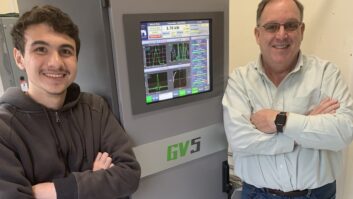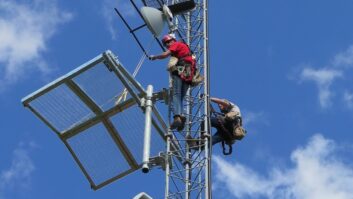With lots of help from its broadcast brethren, equipment manufacturers and the Society of Broadcast Engineers, a student-run radio station here is moving forward with plans to upgrade its signal through a proposed power increase and antenna move.
WUTV(FM) gained the industry’s attention following last year’s shootings at the Virginia Polytechnic Institute and State University, known widely as Virginia Tech.
Kevin Sterne, the station’s chief engineer, was shot twice through his right leg while sitting in the classroom where the attack took place in April of 2007.
More than a year later, Sterne, 23, says he is still recovering from the physical and emotional wounds.
Several industry groups stepped forward with equipment and labor in Sterne’s absence to assist WUVT with emergency engineering needs. For several months the station’s 24-year-old transmitter had been languishing, which relegated the station to low-power mode.
“WUVT was limping along at a percentage of their licensed power and they were suffering from antenna problems,” said Barry Thomas, now the president of SBE. “We were able to gather a huge mass of equipment and support for the station in a short time.”
Equipment contributors included Clear Channel, Cumulus Media, Harris Broadcast, Electronic Research Inc., Orban and Broadcast Electronics, Thomas said.
He specifically noted the assistance of Steve Davis, senior vice president of engineering and management at Clear Channel Radio, for his help.
Price Mountain project
WUVT is still using a loaner Harris ZX-3500 transmitter from Clear Channel and a Flexstar exciter donated by Harris, Thomas said.
With its immediate broadcast needs addressed, attention has turned to planning a power increase and eventually moving the antenna from atop Lee Hall, a dorm on campus, to an existing tower on nearby Price Mountain. WUVT hopes to collocate with several commercial FMs at the facility.
Thomas said SBE General Counsel Chris Imlay and Dane Ericksen, consulting engineer with Hammett & Edison, put in many hours of pro bono work on behalf of SBE on the project. Imlay provided legal advice and prepared the non-engineering portions of the NCE application during the FCC’s non-commercial filing window last fall.
Ericksen, who completed interference studies and prepared the engineering portion of the FCC filing, said SBE and others stepped up to help a fellow broadcaster.
“We did all of the work we would normally do for a non-commercial client. But this was a special case that we were happy to help with,” he said.
Ericksen said he figured out height and coordinates of the new site and plugged in supplemental coverage maps in his efforts to ensure the success of the FCC filing.
WUVT is seeking a power increase from 3.5 kW to 10 kW. Station officials say the changes would allow the station to reach further outside the local Blacksburg community.
If WUVT’s power increase is granted, Clear Channel has a Harris Z-5 for the station to use with a digital exciter already tuned to 90.7 MHz, the school station’s frequency, said Davis.
Clear Channel also has pledged help with moving the station’s permanent transmitter to its new location on Price Mountain and donated a transmitter building, he said.
Upgrade obstacles
Despite the industry’s goodwill donations of equipment and manpower, the radio station still faces obstacles in its efforts to upgrade its signal.
A co-channel FM in Emory, Va., licensed to Emory & Henry College, filed its application to increase power on the very same day as Virginia Tech officials did. WEHC(FM) has asked for FCC approval to go from its current 500 watts of power to 10 kW.
Emory, Va., is approximately 45 miles southwest of the city of Blacksburg.
“Despite doing as much as we could to avoid competing applications, we drew one anyway. I understand it is being resolved through technical amendments to both applications,” Imlay said.
Being “mutually exclusive” is unfortunate, said Ericksen, who expects there will be swapping of proposals between the sides.
Virginia Tech officials confirmed that talks have been held with Emory & Henry administrators and William Culpepper, their consulting engineer on the broadcast project.
“The overlap is not the end of the world and it is negotiable,” Ericksen said. “We will continue to support [the] school and work with the Emory people to hammer out some modifications. This is fixable.”
It’s unclear exactly how long negotiations could take to resolve the conflicting applications, Ericksen said.
However, he expects the WUVT signal upgrade likely won’t be as significant as it originally hoped. Ericksen said his new calculations suggest a lower ERP of 6.5 kW.
“Barring any kind of fatal flaw discovered in the Emory filing, the solution will be an overall power reduction in all directions for both stations,” Ericksen said.
According to one source familiar with the situation, Emory & Henry administrators are expected to approve a similar power reduction for WEHC to eliminate the overlapping contours.
The modifications to their FCC applications would result in WUVT remaining a Class C3 FM and WEHC a Class A FM, Ericksen said.
One day at a time
As for Sterne, who joined WUVT in 2003 and helped spearhead initial efforts to upgrade its technical facilities, said he is thankful for the radio industry’s support throughout his ordeal.
Associated Press transmitted an image of Sterne, in bloodstained clothing, being carried in the arms of police officers across the school grounds to safety. The shooter, Seung Hui Cho, killed 32 students and faculty that day.
Sterne, who still undergoes physical therapy for his wounds, probably saved his own life by fashioning a tourniquet from electrical cord to stop his bleeding. He returned to the radio station four months later but still thinks daily about the shooting spree.
“Some days are good and some are bad. Thankfully the pain has subsided for now, even though some days I have slight stinging pains or some general aches. Everyone has their own way of moving on, but it’s something I’ll never forget.”
Sterne, who is working on his master’s degree in electrical engineering at the school, is undecided about his long-term job plans, though he said a career in broadcasting is a possibility.
“I’m only focusing on finishing my master’s and helping the radio station right now. I would like to stay in broadcasting,” Sterne said.
WUVT, which has a mostly volunteer staff, is known for its eclectic music and student DJs. The non-commercial station celebrated its 60th year on the air in April.
Kim Foley, general manager of WUVT, said the outreach and support the station received from the broadcasting community could not have come at a better time.
“I can never thank everyone enough times for what they did for WUVT. I was exhausted and frustrated by that point with everything that happened in the semester. For everyone to reach out to us and show such kindness meant so much to all of us,” Foley said.












